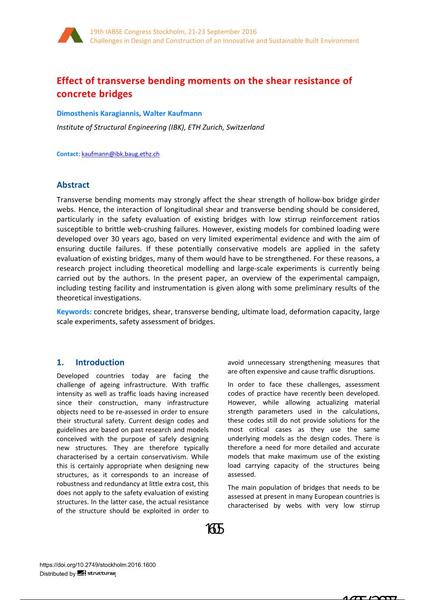Effect of transverse bending moments on the shear resistance of concrete bridges

|
|
|||||||||||
Bibliografische Angaben
| Autor(en): |
Dimosthenis Karagiannis
(Institute of Structural Engineering (IBK), ETH Zurich, Switzerland)
Walter Kaufmann (Institute of Structural Engineering (IBK), ETH Zurich, Switzerland) |
||||
|---|---|---|---|---|---|
| Medium: | Tagungsbeitrag | ||||
| Sprache(n): | Englisch | ||||
| Tagung: | IABSE Congress: Challenges in Design and Construction of an Innovative and Sustainable Built Environment, Stockholm, Sweden, 21-23 September 2016 | ||||
| Veröffentlicht in: | IABSE Congress Stockholm, 2016 | ||||
|
|||||
| Seite(n): | 1605-1612 | ||||
| Anzahl der Seiten (im PDF): | 8 | ||||
| Jahr: | 2016 | ||||
| DOI: | 10.2749/stockholm.2016.1600 | ||||
| Abstrakt: |
Transverse bending moments may strongly affect the shear strength of hollow-box bridge girder webs. Hence, the interaction of longitudinal shear and transverse bending should be considered, particularly in the safety evaluation of existing bridges with low stirrup reinforcement ratios susceptible to brittle web-crushing failures. However, existing models for combined loading were developed over 30 years ago, based on very limited experimental evidence and with the aim of ensuring ductile failures. If these potentially conservative models are applied in the safety evaluation of existing bridges, many of them would have to be strengthened. For these reasons, a research project including theoretical modelling and large-scale experiments is currently being carried out by the authors. In the present paper, an overview of the experimental campaign, including testing facility and instrumentation is given along with some preliminary results of the theoretical investigations. |
||||
| Stichwörter: |
Verformungskapazität Schub Betonbrücke
|
||||

